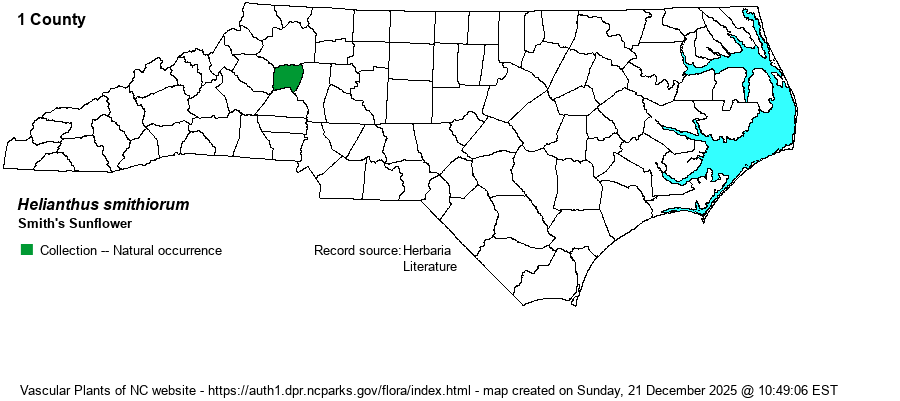| Author | Heiser | |
| Distribution | There is a collection record for Alexander County in 2010. The specimen (at NCU) appears to be correctly identified (Sorrie, pers. obs.). Collected by James Padgett on 11 Aug. 2010 in Alexander County. The specimen needs to be examined by an expert in this genus.
Western NC and southeastern TN, south to northern GA and northeastern AL. | |
| Abundance | The situation in NC is unsettled, such that the NCNHP has yet to place the species on its Significantly Rare list, but they have placed it on the Watch List as W3 (not conclusive documentation). Their Biotics database indicates they are withholding tracking the species as Significantly Rare until more data come to light concerning the status of H. smithiorum as a good species or as a hybrid entity. They also rank it at SU (Undetermined), though the editors suggest S1. | |
| Habitat | Weakley (2020) gives the habitat in its range as "Dry forests and woodlands", which is quite generic and does not explain the extreme rarity of the species in NC. Perhaps it is limited to high pH soil. NatureServe Explorer agrees on this habitat assessment: "Open, oak-hickory-pine uplands. Prefers moderately sized forest openings, including persistently open areas such as dolomite glades." | |
| Phenology | Flowering and fruiting August-September. | |
| Identification | See text in Weakley (2018) and FNA (2006). Weakley (2018) does state that it has linear-lanceolate leaves, with just a single main vein. Otherwise, it keys fairly closely to Small Wood Sunflower (H. microcephalus), though it shouldn't, as the leaves are much narrower on this species than on H. microcephalus. Photos on Google images show these quite narrow and essentially entire leaves, probably the most obvious identification character. | |
| Taxonomic Comments | Some authors consider it a hybrid of H. strumosus x microcephalus. Others, such as Cronquist (1980), lump it into the latter. This website certainly considers it minimally as a Watch List species, though theoretically it could be listed here as either W2 (Rare but Questionable Taxonomy), W3 (Rare but Questionable Documentation), or even W4 (Rare but Possibly Not Native)! The editors will use W3 for now. NOTE: Weakley (2024) changed the specific epithet from smithii to smithiorum, saying "The epithet must be corrected to "smithiorum", as Heiser intended it to commemorate two Smiths".
| |
| Other Common Name(s) | None | |
| State Rank | SU [S1] | |
| Global Rank | G2Q | |
| State Status | W3 | |
| US Status | | |
| USACE-agcp | | |
| USACE-emp | | |

